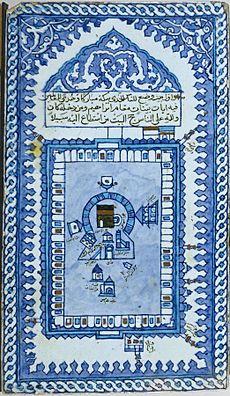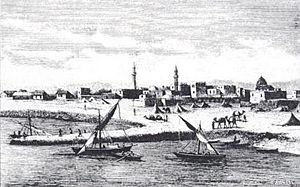Ibn Battuta facts for kids
Quick facts for kids
Ibn Battuta
|
|
|---|---|
| ابن بطوطة | |

1878 illustration by Léon Benett showing Ibn Battuta (center) and his guide (left) in Egypt
|
|
| Born | 24 February 1304 |
| Died | 1369 (aged 64–65) Marrakech, Marinid Sultanate
|
| Other names |
|
| Occupation | Geographer, explorer, scholar |
| Era | Post-classical history |
|
Notable work
|
Rihla |
| Arabic name | |
| Personal (Ism) | Shams al-Din |
| Patronymic (Nasab) | Muḥammad ibn ʿAbd Allāh Muḥammad ibn Ibraḥim ibn Muḥammad ibn Yusuf |
| Teknonymic (Kunya) | ʾAbū ʿAbd Allāh |
| Epithet (Laqab) | ibn Baṭṭūṭah |
Ibn Battuta was an amazing Berber scholar and explorer from North Africa. He traveled more than anyone else in ancient times! Imagine covering about 117,000 kilometers (72,700 miles). This is much more than famous explorers like Marco Polo or Zheng He.
For thirty years, Ibn Battuta explored most of southern Eurasia. This included places like Central Asia, Southeast Asia, South Asia, China, and even the Iberian Peninsula (modern-day Spain and Portugal). Near the end of his life, he wrote down all his adventures in a book called The Rihla. This book is a true treasure, telling us about the world in the 1300s.
Contents
Who was Ibn Battuta?
Ibn Battuta's full name was Abu Abdullah Muhammad ibn Battuta. His last name, Ibn Battuta, means "son of the duckling." In his travel book, The Rihla, he gives an even longer name. It was Shams al-Din Abu’Abdallah Muhammad ibn’Abdallah ibn Muhammad ibn Ibrahim ibn Muhammad ibn Yusuf Lawati al-Tanji ibn Battuta.
Early Life and Education
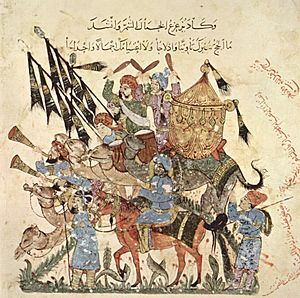
We know about Ibn Battuta's early life mostly from his own travel stories. He was born in Tangier, Morocco, on February 24, 1304. His family belonged to a Berber tribe called the Lawata. They were known for being legal scholars, also called qadis (judges) in the Muslim world.
As a young man, Ibn Battuta studied Islamic law. This was the main type of education in North Africa back then. Because he was from a family of judges, people often asked him to serve as a religious judge during his travels.
Ibn Battuta's Incredible Journeys
First Big Adventure: The Pilgrimage
In June 1325, at age 21, Ibn Battuta began his first big journey. He left his hometown to go on a hajj, a pilgrimage to Mecca. This trip usually took about 16 months. He was excited to see new lands and have adventures. Little did he know, he wouldn't return home for 24 years!
He traveled by land along the North African coast. He passed through cities like Tlemcen, Béjaïa, and Tunis. For safety, he often joined a caravan (a group of travelers). This helped protect them from robbers.
In early 1326, after traveling over 3,500 kilometers (2,175 miles), Ibn Battuta reached Alexandria in Egypt. Here, he met two holy men. One of them, Sheikh Burhanuddin, even predicted that Ibn Battuta would become a famous world traveler.
He spent weeks exploring Alexandria, then went to Cairo. Cairo was a very important city and the capital of the Mamluk Sultanate. After a month in Cairo, he tried to go to Mecca by sailing up the Nile river. But a local rebellion forced him to turn back.
So, Ibn Battuta went back to Cairo and then took another trip to Damascus. A holy man had told him he would only reach Mecca by going through Syria. This route was also safer because the Mamluk rulers protected pilgrims.
After spending the Muslim month of Ramadan in Damascus, he joined a caravan. They traveled 1,300 kilometers (800 miles) south to Medina. This city is home to the Mosque of the Islamic prophet Muhammad. After four days there, he continued to Mecca. When he arrived, he completed his first pilgrimage and earned the title El-Hajji. But instead of going home, he decided to keep traveling!
Exploring Iraq and Iran
After his pilgrimage, Ibn Battuta joined a large caravan heading to Iraq. They traveled across the Arabian Peninsula to Najaf. There, he visited the tomb of Ali, an important Muslim leader.
He then took a six-month detour into Iran. He visited cities like Basra, Isfahan, and Shiraz. Shiraz was a beautiful city that had escaped destruction by the Mongols. Finally, he returned to Baghdad in June 1327. Parts of Baghdad were still ruined from a Mongol invasion years before.
In Baghdad, he met Abu Sa'id, the last Mongol ruler of the Ilkhanate. Ibn Battuta even joined the royal group for a while. He then traveled north on the Silk Road to Tabriz, a major trading city.
He went back to Baghdad, but first explored along the Tigris river. He visited Mosul, Cizre, and Mardin. After getting sick, he returned to Baghdad. He then joined another caravan to Mecca for his second pilgrimage.
Adventures in Arabia and East Africa

Ibn Battuta stayed in Mecca for about three years. After his pilgrimage in 1328 or 1330, he went to the port of Jeddah. From there, he sailed along the Red Sea coast. He visited Yemen, including the towns of Zabīd and Ta'izz. He also mentioned visiting Sana'a, but it's not clear if he actually went there. He arrived in the trading port of Aden around 1329 or 1331.
From Aden, Ibn Battuta sailed to Zeila on the coast of Somalia. He also visited Mogadishu, which was a very rich city at the time. He described it as "an exceedingly large city" with many wealthy merchants. The city was famous for its high-quality fabric. He noted that the Sultan of Mogadishu, Abu Bakr ibn Shaikh 'Umar, was a Somali speaker who also knew Arabic.
Ibn Battuta continued by ship south along the Swahili coast. He stopped at Mombasa and then reached Kilwa in Tanzania. Kilwa was an important center for the gold trade. He described it as "one of the finest and most beautifully built towns." He was very impressed by the city's planning and its large mosque made of coral stones.
After exploring the Swahili coast, Ibn Battuta sailed back to Arabia. He visited Oman and the Strait of Hormuz. Then, he went to Mecca for his third pilgrimage in 1330 or 1332.
Journey to Asia: 1332–1347
After his third pilgrimage to Mecca, Ibn Battuta decided to find work with the Sultan of Delhi in India. In the autumn of 1330 or 1332, he set off for Anatolia (modern-day Turkey). He planned to travel by land to India.
Across Anatolia

He crossed the Red Sea and the desert to reach the Nile valley. Then he went north to Cairo. From there, he crossed the Sinai Peninsula to Palestine and traveled north again. From the Syrian port of Latakia, a ship took him to Alanya on Turkey's southern coast.
He traveled west along the coast to Antalya. Here, he met members of special groups called fityan. These groups were young craftspeople who welcomed travelers. Ibn Battuta was very impressed by their kindness. He stayed in their guesthouses in many towns across Anatolia.
He also visited Bursa, which was the capital of the Ottoman Empire at the time. He described Bursa as "a great and important city with fine bazaars and wide streets." He also visited other areas, where he was given slaves as gifts. This showed his growing wealth and importance.
Through Central Asia
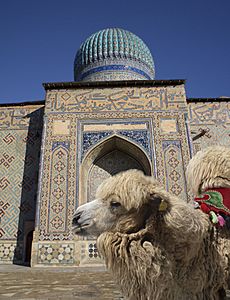
From Sinope, he sailed to the Crimean Peninsula. This was part of the Golden Horde realm. He visited the port town of Azov and the city of Majar. He then met with the Khan's traveling court near Mount Beshtau.
He traveled north to Bolghar, the northernmost point he reached. He noticed how short the summer nights were there. He also heard about a mysterious people in the far north who traded furs without ever showing themselves. Merchants would leave goods, and the next morning, furs would be there in exchange.

In Astrakhan, Ibn Battuta joined a group traveling to Constantinople. This was his first trip outside the Islamic world. In Constantinople, he met the Byzantine emperor Andronikos III Palaiologos. He visited the famous church of Hagia Sophia. After a month, he returned to Astrakhan.
He continued his journey, passing the Caspian Sea and Aral Sea. He visited Bukhara and Samarkand, meeting another Mongol ruler. From there, he went south to Afghanistan. He crossed into India through the Hindu Kush mountains. He wrote that these mountains were called "Hindu-slayer" because many slaves brought from India died there from the cold.
Ibn Battuta reached the Indus River on September 12, 1333. From there, he made his way to Delhi, India.
Life in the Indian Subcontinent

In Delhi, Ibn Battuta met Sultan Muhammad bin Tughluq. The Sultan was known as the richest man in the Muslim world. He liked to support scholars and judges. Because of his studies, Ibn Battuta was appointed a qadi, or judge, by the Sultan. However, it was hard for him to apply Islamic law outside the Sultan's court in Delhi.
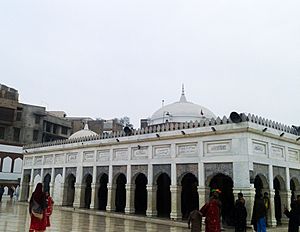
Ibn Battuta was kidnapped and robbed by bandits on his way to the Indian coast. But he managed to rejoin his group and continued to Khambhat in India. From there, they sailed to Calicut. While he was visiting a mosque, a storm sank one of his ships. The other ship sailed away without him.
Afraid to return to Delhi, he stayed in southern India for a while. He then decided to visit the Maldive Islands. He ended up working there as a judge.
Judge in the Maldives
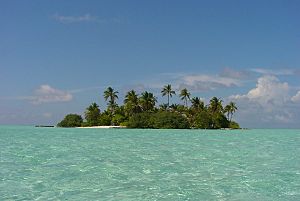
Ibn Battuta stayed in the Maldives for nine months. The leaders of the islands, who had recently become Muslim, needed a chief judge. They offered him gifts like pearls, gold, and slaves to convince him to stay. They also made it hard for him to leave. So, he became the chief judge and even married into the royal family.
He tried to make the local laws stricter, following Muslim law more closely. For example, he ordered public whippings for men who missed Friday prayers. But these strict rules made some of the island's rulers unhappy. He eventually resigned from his job.
Ibn Battuta often married women in places where he stayed for a long time. He would then divorce them when he moved on. In the Maldives, he married four women.
From the Maldives, he went to Sri Lanka and visited Sri Pada. His ship almost sank, and then pirates attacked the rescue vessel. Stranded, he made his way back to India. He then returned to the Maldives and boarded a Chinese ship, still determined to reach China.
Exploring Southeast Asia
In 1345, Ibn Battuta traveled to the Samudera Pasai Sultanate in Sumatra. He noted that the ruler, Sultan Al-Malik Al-Zahir Jamal-ad-Din, was a very religious Muslim. The island of Sumatra was rich in valuable goods like camphor, cloves, and tin.
He then sailed to a place called Mul Jawa, which was a Hindu empire. He also visited a state called Kaylukari, where he met a brave warrior princess named Urduja. The exact location of Kaylukari is debated, but some believe it was in the Philippines.
Adventures in China
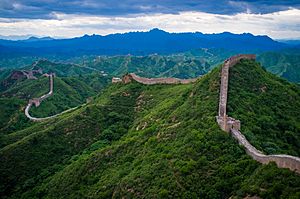
In 1345, Ibn Battuta finally arrived in Quanzhou, China. This city was ruled by the Mongol-led Yuan dynasty. He noticed that Muslims called the city "Zaitun," meaning "olive," but he couldn't find any olives there. He was amazed by the local artists who could draw portraits of new visitors for security reasons. He also praised the Chinese craftsmen for their silk and porcelain.
He described how large ships were built in Quanzhou. He also mentioned Chinese food, including animals like frogs, pigs, and even dogs sold in markets. He noted that Chinese chickens were larger than those in the west.
In Quanzhou, he was welcomed by the head of the local Muslim merchants. He stayed in the Muslim quarter, which had its own mosques and markets. He then traveled south to Guangzhou.
From Guangzhou, he went north to Fuzhou and then to Hangzhou. Ibn Battuta said Hangzhou was one of the largest cities he had ever seen. He loved its beautiful lake and green hills. He was impressed by the many well-made Chinese wooden ships on the canals.
He traveled along the Grand Canal by boat, seeing farms and merchants. In Beijing, Ibn Battuta claimed to be an ambassador from the Delhi Sultanate. He was invited to the Yuan imperial court. He noted that the palace was made of wood.
Ibn Battuta also wrote that he heard about "the rampart of Gog and Magog" (the Great Wall of China). He believed it was built to keep out certain groups, as mentioned in the Quran. However, he couldn't find anyone in China who had actually seen it.
After returning to Quanzhou, he boarded a ship heading for Southeast Asia. Unfortunately, the crew charged him a lot of money, and he lost many of the things he had collected in China.
The Long Journey Home
After his time in China, Ibn Battuta began his journey back to Morocco in 1346. In Kozhikode, he thought about returning to Delhi, but decided against it. He chose to go back to Mecca instead. On his way, he learned that the last ruler of the Ilkhanate Dynasty in Iran had died. This led to civil war in the region.
In 1348, Ibn Battuta arrived in Damascus. He planned to retrace his first pilgrimage route. But then he learned that his father had died 15 years earlier. The Black Death (a terrible plague) had also spread. He saw many deaths in Syria, Palestine, and Egypt. He made his pilgrimage to Mecca one last time.
Finally, in 1349, he returned to Tangier, Morocco, almost 25 years after he left. He then found out that his mother had also died a few months before.
Final Travels: Spain and West Africa
After a few days in Tangier, Ibn Battuta went on a trip to al-Andalus (Muslim-controlled Spain). He joined a group of Muslims to defend Gibraltar from attack. But the Black Death had killed the attacking king, so the threat was gone. He turned the trip into a sightseeing tour, ending in Granada.
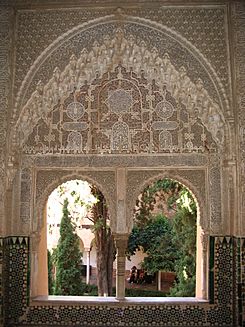
After Spain, he traveled through Morocco. He stopped in Marrakech, which was almost empty because of the plague.
Across the Sahara to Mali
In autumn 1351, Ibn Battuta left Fez and went to Sijilmasa. This town was on the edge of the Sahara desert. He bought camels and stayed for four months. In February 1352, he set off with a caravan. After 25 days, they reached the salt mines of Taghaza. All the buildings there were made of salt!
After ten days, the caravan continued across the vast desert. They traveled for two months to cross 1,600 kilometers (1,000 miles) of desert. They finally reached the oasis town of Oualata, which was part of the Mali Empire.
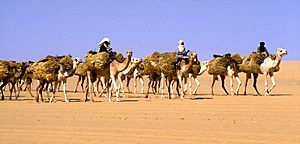
From Oualata, Ibn Battuta traveled southwest along a river he thought was the Nile (it was actually the Niger). He reached the capital of the Mali Empire and met its king, Mansa Suleyman.
He left the capital in February and traveled by camel to Timbuktu. At that time, Timbuktu was a small city. During this journey, Ibn Battuta saw a hippopotamus for the first time. After a short stay, he traveled down the Niger river to Gao in a canoe. Gao was an important trading center.
After a month in Gao, Ibn Battuta set off with a large caravan for the oasis of Takedda. On this desert journey, he received a message from the Sultan of Morocco telling him to return home. He set off for Sijilmasa in September 1353. He arrived back in Morocco in early 1354.
Ibn Battuta's travels helped scholars understand when Islam first began to spread into West Africa.
His Famous Book: The Rihla
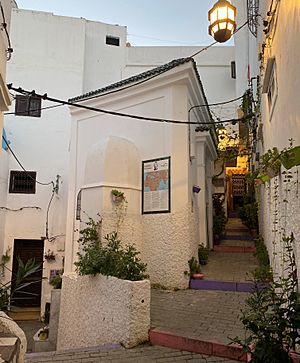
After returning home in 1354, Ibn Battuta told the story of his journeys to a scholar named Ibn Juzayy. This account is the only source we have for Ibn Battuta's amazing adventures. The full title of the book is A Masterpiece to Those Who Contemplate the Wonders of Cities and the Marvels of Travelling. But it's usually just called The Rihla (which means "The Travels").
Ibn Battuta didn't keep a diary during his travels. So, when he told his story, he had to rely on his memory. He also used information from other travelers' writings. Sometimes, Ibn Juzayy presented these older descriptions as if Ibn Battuta had seen them himself. For example, some parts about Damascus and Mecca were copied from a traveler named Ibn Jubayr who wrote 150 years earlier.
Some scholars don't believe Ibn Battuta visited every place he described. They think he used information from others to make his book more complete. For example, it's unlikely he traveled up the Volga River to Bolghar. There are also doubts about his trip to Sana'a in Yemen.
Despite these questions, The Rihla is a very important book. It gives us a detailed look at much of the world in the 1300s. Ibn Battuta often experienced "culture shock" when local customs were different from his own strict Muslim background. For example, he was surprised by the freedom and respect women had among the Turks and Mongols. He also felt that clothing in the Maldives and parts of Africa was too revealing.
We don't know much about Ibn Battuta's life after he finished his book in 1355. He became a judge in Morocco and died in 1368 or 1369.
Ibn Battuta's work was not known outside the Muslim world until the early 1800s. That's when European explorers found copies of his book. Scholars then translated it into English and French, making his incredible story known to the rest of the world.
Is the Rihla a True Story?
Some scholars, like Ralph Elger, think that parts of Ibn Battuta's travel account might be fiction. They believe it was put together using other travel reports. However, other scholars, like Tim Mackintosh-Smith, have found evidence that supports parts of the Rihla. For example, they found copies of Islamic law documents that Ibn Battuta copied in Damascus in 1326. This matches the dates in his book.
So, while some details might be debated, Ibn Battuta's Rihla remains an amazing and valuable record of his time.
See also
 In Spanish: Ibn Battuta para niños
In Spanish: Ibn Battuta para niños


